Gas Trackers ⛽
Real-time information on gas prices, transaction fees and network congestion levels for developers building dApps on the blockchain.
Gas tracker in blockchain
A gas tracker is a tool that allows users to monitor and track the amount of gas being used by transactions on the network. Gas is a measure of computational effort required to execute a transaction on the blockchain, and is necessary to prevent spamming and other such activities on the network.
By providing network congestion levels, gas prices and transaction fees users can easily estimate the cost of their transactions and make informed decisions about how much gas to use for their transactions.
Gas trackers are particularly important for users who want to optimize the performance and cost-effectiveness of their transactions on the blockchain.
How gas works on blockchains
Gas is typically priced in the network's native cryptocurrency, and is used to compensate the network nodes that validate and process the transaction.
In blockchain networks like Ethereum, gas is used to prevent spamming and other malicious activities on the network by requiring users to pay a fee to execute their transactions.
The amount of gas required for a transaction is determined by its complexity, and can vary depending on factors such as the number of computational steps required, the size of the data being processed, and the network's congestion levels.
For developers building decentralized applications (dApps) on the blockchain, gas trackers are particularly useful for optimizing the performance and cost-effectiveness of their smart contracts. By monitoring and tracking their gas usage, developers can make informed decisions about how to write their code to minimize gas costs and improve the efficiency of their dApps on the network. Don’t stop here. Browse free courses at Metaschool

